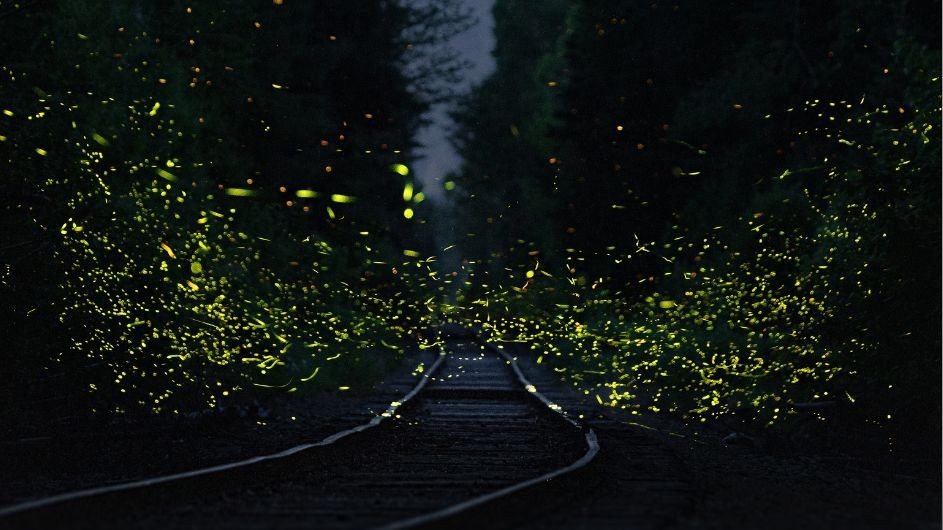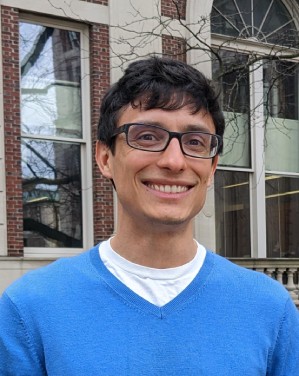Following Light, from One Atom to Many
Postdoc Ricardo Gutiérrez Jáuregui talks about studying light at Columbia and returning home to Mexico City.

Every summer around the Great Smoky Mountains, Photinus carolinus fireflies light up the night in stunning displays of synchronized blinking. It’s a collective behavior that theoretical physicist Ricardo Gutiérrez Jáuregui finds analogous to that of the atoms he studies, which also “blink” on and off as they absorb and emit quantum particles of light called photons. He noted recent studies showing that the fireflies only synchronize with one another under certain conditions—not unlike what he observed as a postdoc working with Ana Asenjo Garcia, assistant professor of physics and quantum optics expert at Columbia.

“When you arrange your atoms in a specific way, it becomes more likely that they’ll blink on and off together,” Gutiérrez Jáuregui said. “It’s not one-to-one, but it’s a pretty example of how you can use quantum physics to understand nature. As we look for how laws emerge in fundamental quantum systems, maybe we can start learning about the fireflies as well.”
Gutiérrez Jáuregui joined Asenjo Garcia’s group in 2019, after completing his PhD at the University of Auckland. He started off as a student at the Universidad Nacional Autonóma de México (UNAM), where he recently returned as a faculty member. Here, he shares how it feels to complete that circle, why one studies the theory of light, and what he’s taking home from his time abroad.
Was it a goal to get back where you started?
I've had close ties to the Universidad Nacional Autonóma de México for a long time, and I always wanted to come back to the culture I was raised in. But it’s funny, sometimes you don’t know if a goal you’ve been following for such a long time is actually what you want anymore. Even though I had lots of collaborators there, I hadn’t lived in Mexico City for ten years. But when I visited before accepting the position, it felt like home. I’m excited to establish my group and increase the quantum optics community in Mexico.
What was your path to Columbia?
My parents are physicists, though they never pushed me towards the subject. Growing up, I remember my father doing magic tricks, which sparked my curiosity in science. In college I realized physics was much more exciting than typical high school problems. I could try to solve these magic questions, just like those tricks my father did.
Learn More About Quantum Optics at Columbia
I moved to New Zealand for my PhD to study with Howard Carmichael, a pioneer of quantum optics. My officemate there was Stuart Masson, who joined Ana Asenjo Garcia’s group as her first postdoc. They are both rising stars in the quantum optics community tackling really ambitious projects. While I was doing a postdoc at Texas A&M, Stuart and Ana invited me to give a talk at Columbia. I felt such a great rapport and so much energy, and afterwards Ana offered me a position.
I had been working with scientists who were really well-established—practically walking encyclopedias. There are more growing pains with a growing group, but it’s been exciting to learn together. The Columbia quantum community has amazing students as well. It's the power of bringing people to New York.
What research questions motivate your work?
I’ve always been interested in light, which really means studying how light interacts with something else. When that something is small like a single atom, you see an interesting choreography as the two briefly merge. In quantum mechanics, this is known as entanglement, and the closest you can get to distinguishing what part is the atom and what the photon is an approximation with the Shroedinger equation.
When light interacts with something big, like a photodetector, you can distinguish the light from the material it is interacting with. But how can you go from an approximation to an actual measurement? What happens in between is a big open question in quantum physics, and it’s not easy to find the boundary. I want to understand the division between what is light and what isn’t as you add more and more atoms, and what rules these bigger systems obey.
Why does that matter?
There are potential applications to consider. For example, blinking atoms are what makes atomic clocks, which are important to GPS systems, “tick”. Adding atoms could make atomic clocks even more precise, but they have to be arranged just right. Quantum information applications, like quantum computers, also need synchronized behaviors. And it’s just also about understanding how the world works, like the fireflies. By understanding something around us better, eventually we can harness it. I could make a beautiful and self-consistent theory, but if it’s unsolvable or doesn't answer a real-world question, at least for me, it's not that interesting.
Have you had any ‘eureka’ moments in your career so far?
One was during my PhD. I was trying to change how photons and atoms merge, while also collaborating with scientists in Mexico who were studying electron transport. You would think these two problems have nothing to do with one another, but we found they share the same equations. Suddenly, we could solve problems in one system by looking at the other.
Another was at Columbia, where I studied arrays of atoms arranged in different patterns. Light emitted from individual atoms will radiate outwards in a wave that interacts with others such that the whole array can become either brighter or darker. We can control this by changing the pattern of the atoms—atoms in a one-dimensional line, for example, will radiate light differently than those spread across a two-dimensional plane. But it turns out it’s not just the path the radiation takes that matters: it’s also what sets the spark in the first place. This is something called quantum fluctuations. When we manipulated the spark, we realized that groups of atoms will attempt to reach a state where, collectively, they are no longer affected by the environment that surrounds them. That’s something I will continue exploring with my own group.
How are you approaching your new group?
When you are a young scientist, it can feel like your discoveries are incredibly new and innovative. There’s some truth to that, but you are always following ideas from great scientists. We can act as a bridge, applying existing knowledge in new ways to advance theories that will help develop quantum technologies.
On the personal side, I learned a lot from Ana and Howard. They care profoundly about their group members growing as both scientists and people. I want to mimic that, and also help my group navigate different pressures in science. Like balancing research you find interesting but that may take time with getting papers published.
Any advice for other young scientists?
As a student, it felt like everything had to be a home run. Otherwise, game over. This is not true. In research, there will be swings and misses. It's way easier to give this advice than apply it, but what matters is what you learned that will help you in your next project.
Another of the biggest challenges in a young scientist’s career these days is the uncertainty. If my contract finishes in a few months, how do I manage to do proper research? How do I start publishing, while also having a life? Your support group is very important, including your groupmates and your family and friends. Whenever I felt stuck, I would also read papers from physicists I respected. You can tell they love what they are doing, but you realize that you are seeing a fantastic paper in its final form—not the path that it took to get there. Keep going, no matter the uncertainty and failures along the way.
